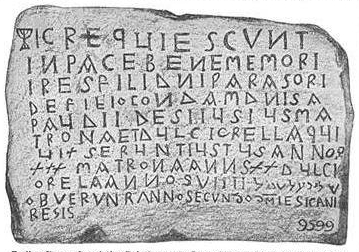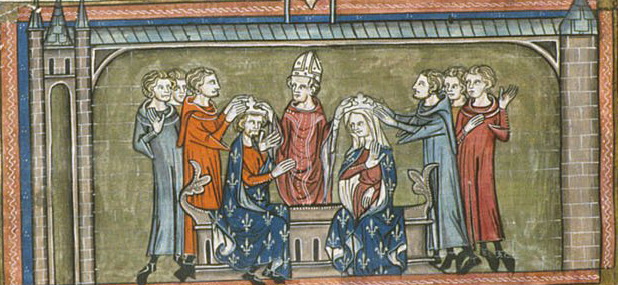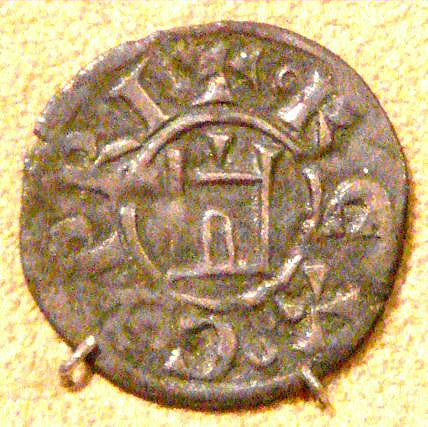|
Theobald IV, Count Of Champagne
Theobald I (, ; 30 May 1201 – 8 July 1253), also called the Troubadour and the Posthumous, was Count of Champagne (as Theobald IV) from birth and King of Navarre from 1234. He initiated the Barons' Crusade, was famous as a trouvère, and was the first Frenchman to rule Navarre. Rule of Champagne Regency of Champagne Born in Troyes, he was the son of Theobald III of Champagne and Blanche of Navarre, the youngest daughter of Sancho VI of Navarre. His father died less than a week before he was born, and Blanche ruled the county as regent until Theobald turned twenty-one in 1222. He was a notable trouvère, and many of his songs have survived, including some with music. The first half of Theobald's life was plagued by a number of difficulties. His uncle, Count Henry II, had left behind a great deal of debt, which was far from paid off when Theobald's father died. Further, Theobald's right to the succession was challenged by Henry's daughter Philippa and her husband, Erard I of Br ... [...More Info...] [...Related Items...] OR: [Wikipedia] [Google] [Baidu] |
King Of Navarre
This is a list of the kings and queens of kingdom of Pamplona, Pamplona, later kingdom of Navarre, Navarre. Pamplona was the primary name of the kingdom until its union with Kingdom of Aragon, Aragon (1076–1134). However, the territorial designation Navarre came into use as an alternative name in the late tenth century, and the name Pamplona was retained well into the twelfth century. House of Íñiguez, 824?–905 The Íñiguez dynasty are credited with founding the Navarrese kingdom (of Pamplona) in or around 824 when they are said to have risen against an attempt to extend Franks, Frankish (Carolingian) authority into the region. The Cordoban sources referred to them as sometimes-rebellious vassals, rather than in the manner used to refer to the Christian realms outside their control. They were supplanted in 905 when an anti-Cordoba coalition placed the succeeding Jiménez dynasty in power. House of Jiménez dynasty, Jiménez, 905–1234 In 905, a coalition of neighbors ... [...More Info...] [...Related Items...] OR: [Wikipedia] [Google] [Baidu] |
Barons' Crusade
The Barons' Crusade (1239–1241), also called the Crusade of 1239, was a crusade to the Holy Land that, in territorial terms, was the most successful crusade since the First Crusade. Called by Pope Gregory IX, the Barons' Crusade broadly embodied the highest point of papal endeavor "to make crusading a universal Christian undertaking." Gregory IX called for a crusade in France, England, and Hungary with different degrees of success. Although the crusaders did not achieve any glorious military victories, they used diplomacy to successfully play the two warring factions of the Ayyubid dynasty ( as-Salih Ismail in Damascus and as-Salih Ayyub in Egypt) against one another for even more concessions than Frederick II had gained during the more well-known Sixth Crusade. For a few years, the Barons' Crusade returned the Kingdom of Jerusalem to its largest size since 1187. This crusade to the Holy Land is sometimes discussed as two separate crusades: that of King Theobald I of Navarre, ... [...More Info...] [...Related Items...] OR: [Wikipedia] [Google] [Baidu] |
Jews In The French Middle Ages
The history of the Jews in France deals with Jews and Jewish communities in France since at least the Early Middle Ages. France was a centre of Jewish learning in the Middle Ages, but persecution increased over time, including multiple expulsions and returns. During the French Revolution in the late 18th century, on the other hand, France was the first European country to emancipate its Jewish population. Antisemitism still occurred in cycles and reached a high in the 1890s, as shown during the Dreyfus affair, and in the 1940s, under Nazi occupation and the Vichy regime. Before 1919, most French Jews lived in Paris, with many being very proud to be fully assimilated into French culture, and they comprised an upscale subgroup. A more traditional Judaism was based in Alsace-Lorraine, which was recovered by The German Empire in 1871 and taken by France in 1918 following World War I. In addition, numerous Jewish refugees and immigrants came from Russia and eastern and central Eur ... [...More Info...] [...Related Items...] OR: [Wikipedia] [Google] [Baidu] |
Louis VIII Of France
Louis VIII (5 September 1187 8 November 1226), nicknamed The Lion (), was King of France from 1223 to 1226. As a prince, he invaded Kingdom of England, England on 21 May 1216 and was Excommunication in the Catholic Church, excommunicated by a papal legate on 29 May 1216. On 2 June 1216, Louis was proclaimed "King of England" by rebellious barons in London, though never crowned. With the assistance of allies in England and Scotland he gained control of approximately one third of the English kingdom and part of Southern Wales. He was eventually defeated by English loyalists and those barons who swapped sides following the death of King John of England, King John. After the Treaty of Lambeth, he was paid 10,000 mark (currency), marks, pledged never to invade England again, and was absolved of his excommunication. As prince and fulfilling his father's crusading vow, Louis led forces during the Albigensian Crusade in support of Simon de Montfort, 5th Earl of Leicester, Simon de Mo ... [...More Info...] [...Related Items...] OR: [Wikipedia] [Google] [Baidu] |
Alice Of Champagne Of Jerusalem
Alice of Champagne (; 1193 – 1246) was the queen consort of Cyprus from 1210 to 1218, regent of Cyprus from 1218 to 1232, and regent of Jerusalem from 1243 to 1246. She was the eldest daughter of Queen Isabella I of Jerusalem and Count Henry II of Champagne. In 1210, Alice married her stepbrother Hugh I of Cyprus, receiving the County of Jaffa as her dowry. After her husband's death in 1218, she assumed the regency for their infant son, King Henry I, but her maternal uncle Philip of Ibelin became the actual head of state administration as bailli (governor). Alice began seeking contacts within her father's counties in France to bolster her claim to Champagne and Brie against her cousin Theobald IV, but the kings of France never acknowledged her claim. After a dispute with Philip of Ibelin, she left the island in 1223. She married Bohemond, heir apparent to the Principality of Antioch and the County of Tripoli, but their marriage was annulled on grounds of consanguinity— ... [...More Info...] [...Related Items...] OR: [Wikipedia] [Google] [Baidu] |
War Of Succession (Champagne)
War is an armed conflict between the armed forces of states, or between governmental forces and armed groups that are organized under a certain command structure and have the capacity to sustain military operations, or between such organized groups. It is generally characterized by widespread violence, destruction, and mortality, using regular or irregular military forces. ''Warfare'' refers to the common activities and characteristics of types of war, or of wars in general. Total war is warfare that is not restricted to purely legitimate military targets, and can result in massive civilian or other non-combatant suffering and casualties. Etymology The English word ''war'' derives from the 11th-century Old English words and , from Old French ( as in modern French), in turn from the Frankish , ultimately deriving from the Proto-Germanic language">Proto-Germanic . The word is related to the Old Saxon , Old High German , and the modern German , meaning . History Anth ... [...More Info...] [...Related Items...] OR: [Wikipedia] [Google] [Baidu] |
Champagne, France
Champagne () was a province in the northeast of the Kingdom of France, now best known as the Champagne wine region for the sparkling white wine that bears its name in modern-day France. The County of Champagne, descended from the early medieval kingdom of Austrasia, passed to the French crown in 1314. Formerly ruled by the counts of Champagne, its western edge is about 160 km (100 miles) east of Paris. The cities of Troyes, Reims, and Épernay are the commercial centers of the area. In 1956, most of Champagne became part of the French administrative region of Champagne-Ardenne, which comprised four departments: Ardennes, Aube, Haute-Marne, and Marne. From 1 January 2016, Champagne-Ardenne merged with the adjoining regions of Alsace and Lorraine to form the new region of Grand Est. Etymology The name ''Champagne'', formerly written ''Champaigne'', comes from French meaning "open country" (suited to military maneuvers) and from Latin ''campanius'' meaning "level c ... [...More Info...] [...Related Items...] OR: [Wikipedia] [Google] [Baidu] |
Ramerupt
Ramerupt () is a commune in the Aube department in north-central France. In 1974, it absorbed the former commune Romaines. '''' n° 0167, 20 July 1973, pp. 7891-7892. Population Personalities * Meir ben Samuel (1060-1135), also known as The RaM, French rabbi and tosafist * |
Erard Of Brienne-Ramerupt
Érard de Brienne (c. 1170 † 1246) was a French nobleman. He was lord of Ramerupt and of Venizy, and also a pretender to the county of Champagne as an instigator of the Champagne War of Succession. He was a son of André of Brienne and of Alix of Vénizy. Early life He was born in Ramerupt, Aube, Champagne, France. He was the son of André of Brienne and Alix of Venizy. A social-climber from a minor branch of the Brienne family, Erard actually held no lands in Brienne and had little just cause to appropriate the name "of Brienne" for himself. His uncle Erard II of Brienne had indeed ruled as count of Brienne. Andre, the brother of Erard II, was the father of Erard of Brienne-Ramerupt. The younger Erard was actually lord of Ramerupt, which wasn't very impressive compared to the holdings of the more senior branches of the Brienne family. Within his own letters, the younger Erard thus tried to enhance his prestige by consistently referring to himself as "Erard of Bri ... [...More Info...] [...Related Items...] OR: [Wikipedia] [Google] [Baidu] |
Henry II Of Champagne
Henry II of Champagne or Henry I of Jerusalem (29 July 1166 – 10 September 1197) was the count of Champagne from 1181 and the king of Jerusalem ''jure uxoris'' from his marriage to Queen Isabella I in 1192 until his death in 1197. Early life Henry was the elder son of Count Henry I of Champagne and Marie, daughter of King Louis VII of France and Duchess Eleanor of Aquitaine. His aunt Adela of Champagne was Louis VII's third wife. In 1171, Henry was betrothed to Isabella of Hainault. When she married Philip II of France instead, his father, aunt and other members of his family were angered. It made Queen Adela's faction hostile to Isabella's family and so caused tension at the French court. Henry's father died in 1181, and his mother ruled, as regent, until 1187. Crusade In 1190 Henry left for the East, after having his barons swear to recognize his younger brother Theobald as his successor should he fail to return. He joined the Third Crusade, arriving ahead of h ... [...More Info...] [...Related Items...] OR: [Wikipedia] [Google] [Baidu] |
Regent
In a monarchy, a regent () is a person appointed to govern a state because the actual monarch is a minor, absent, incapacitated or unable to discharge their powers and duties, or the throne is vacant and a new monarch has not yet been determined. The rule of a regent or regents is called a regency. A regent or regency council may be formed ''ad hoc'' or in accordance with a constitutional rule. ''Regent'' is sometimes a formal title granted to a monarch's most trusted advisor or personal assistant. If the regent is holding the position due to their being in the line of succession, the compound term '' prince regent'' is often used; if the regent of a minor is their mother, and she is wife or widow of the king, she would be referred to as ''queen regent''. If the formally appointed regent is unavailable or cannot serve on a temporary basis, a may be appointed to fill the gap. In a monarchy, a regent usually governs due to one of these reasons, but may also be elected to ... [...More Info...] [...Related Items...] OR: [Wikipedia] [Google] [Baidu] |
Sancho VI Of Navarre
Sancho Garcés VI (; 21 April 1132 – 27 June 1194), called the Wise (, ) was King of Navarre from 1150 until his death in 1194. He was the first monarch to officially drop the title of ''King of Pamplona'' in favour of King of Navarre, thus changing the designation of his kingdom. Sancho Garcés was responsible for bringing his kingdom into the political orbit of Europe. He was the eldest son of García Ramírez, ''the Restorer'' and Margaret of L'Aigle. Biography Sancho VI inherited a debilitated kingdom, subject of frequent raids by the Kingdom of Castile of Alfonso VII and by the County of Barcelona of Ramon Berenguer IV, also king of Aragon, who in 1140 had agreed the partition of the kingdom in the Treaty of Carrión. He tried to repair the borders of his kingdom, which had been reduced by the Treaties of Tudején and Carrión, which he had been forced to sign with Castile and Aragón in his early reign. By the Accord of Soria, Castile was eventually confirmed in ... [...More Info...] [...Related Items...] OR: [Wikipedia] [Google] [Baidu] |





